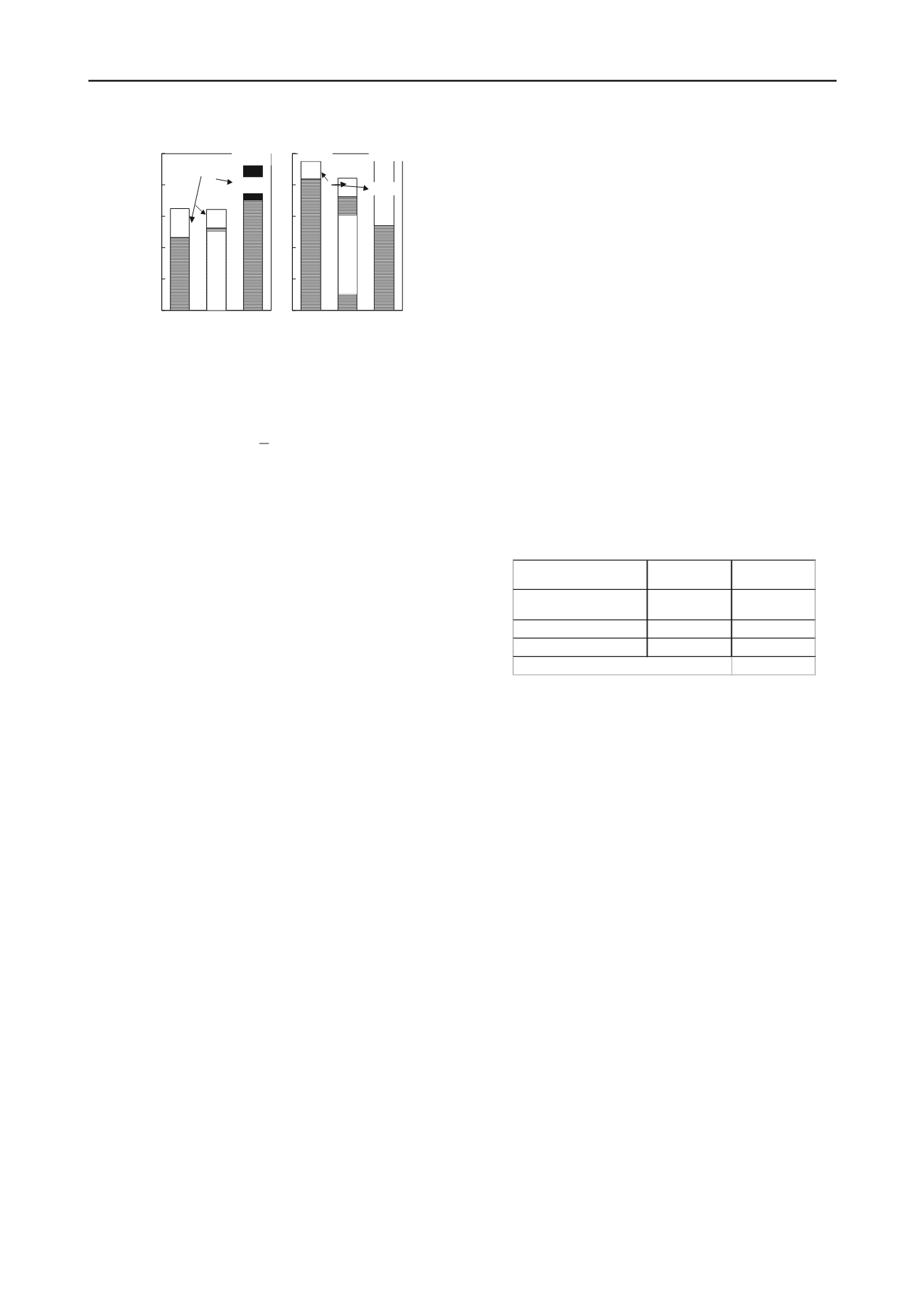
640
Proceedings of the 18
th
International Conference on Soil Mechanics and Geotechnical Engineering, Paris 2013
'
3
2 tan 0.1
'
'
z
c f
i
(7)
where, z is an arbitrary depth from the surface and
L is a
penetration depth from the bearing stratum (see Figure 6).
5 FULL-SCALE PILE LOAD TESTS AND THE
REDUCTION OF FACTOR OF SAFETY
In order to verify the applicability of the presented model and to
confirm the characteristics of the pile bearing capacity of each
layer, full scale pile load tests were conducted at two
representative sites, which locate at 12P and 22P sites shown in
Figure 3. As an important engineering judgment in this project,
the reduction of the factor of safety from 3.0 to 2.5 for pile
foundation design was discussed through comparing the
predicted results with the results of full scale pile load tests.
Figure 7 shows the soil profiles and N values with depth for
12P site. N-values can be seen to widely change with depth
from nearly zero to more than 20 and also N-values at pile tips
are roughly 30. The steel piles with a diameter of 1.0m were
carefully driven using vibration and hydraulic hummers. The
effective length of each pile was about 30m. Tests were
conducted based on the multi-cycles method, which is
recommended by the JGS (1993). Four strain gauges were
located at each of the cross sections as shown by the dots in
Figure 7.
Figure 8 shows the comparison of the estimating total
vertical bearing capacities with those of full-scale pile load tests
at 12P and 22P sites, in which Eqs. (6) and (7) was used to
calculate the predicted values. The bearing capacity calculated
by the empirical model based on the measured N-values
recommended by JRA is also depicted in this figure. The model
used here can reasonably estimate both total skin friction and
pile tip resistance at both sites, comparing with those from JRA
recommendation. As shown in Table 1 and Figure 3, we have a
clear grasp of the soil characteristics values for each layer and a
practically efficient geotecnical profile. Therefore, the model
can apply very well to evaluate the pile bearing capacity
according to the ground profile at each site, with the
consequence that the accuracy of the prediction clearly
increased and these facts became an important evidence to
reduce the factor of safety for pile foundation design from 3.0 to
2.5.
6 EFFECT OF A REDUCTION IN TOTAL COSTS
The comparison of the cost performance in terms of the
construction of pile foundations driven in P1 to P24 sites is
summarized in Table 2, which is a result of trial calculation.
Note that the cost is normalized by the cost obtained by the
standard manner for evaluating the pile bearing capacity using
N-values (JRA, 1993) without any full scale pile load tests. For
comparison, the layer of the bearing stratum for each case was
assumed to be same, however, the penetration depth
L was
considered to depend on the calculation manner. Total cost are
divided by 2 parts, in which one is the part for the cost related to
the geotechnical investigations which include in-situ and
laboratory soil tests, and full scale pile load tests, and the other
is related to the normalized total pile construction cost in terms
of P1 to P24 piers. The presented manner used here is expected
to cut the cost more than 15% comparing with the total cost by
the standard approach using N-values. Thus even if the cost of
the geotechnical investigations became roughly two times
higher comparing with the general manner, the appropriate in-
situ and laboratory investigation with a reasonable
considerations can reduce the total cost in the project. This is
due to the highly accurate ground profile and the proper
evaluation method of pile bearing capacity with the results of
the full scale pile load tests which reflected the decrease of
safety factor from 3.0 to 2.5. It is believed that the geotechnical
considerations and manner treated here can give an important
information for the geotechnical investigators, structural
designers and construction engineers.
(b) P22
Total skin friction
4.6MN
0
2
4
6
8
10
Measured
Values
Predicted
Values
N-Values
Total bearing capacity
9.5MN
8.4MN
Pile-tip resistance
10.0MN
(a) P12
Total skin friction
9.19
0
2
4
6
8
10
Measured
Values
Predicted
Values
N-Values
Total bearing capacity
6.5MN
16.2MN
Pile-tip resistance
6.4MN
9.2MN
Figure 8. Comparison of predicted total bearing capacities with
those of pile load tests
Table 2. Total cost benefit
Method by N-
values
Method
proposed here
Cost for geotechnical
investigations*
1
2.11
Construction cost for piles
1
0.82
Total cost
1
0.84
* the cost includes full scale load tests
7 CONCLUSIONS
An importance of integrating the geotechnical investigations
with pile foundation design was clarified through a case study
in terms of connecting bridge for New-Kitakyushu airport. The
following major conclusions were drawn:
1) A rational method for evaluating the pile bearing capacity
was presented which reflected the soil characteristic values and
geological environmental history. In addition, the applicability
of the presented method was confirmed through full-scale pile
load tests, with the consequence that the safety factors for pile
foundation design were reduced from 3.0 to 2.5.
2) In-situ and laboratory investigation with reasonable
geotechnical considerations can reduce the total cost of the
construction of the bridge for New-Kitakyushu airport.
8 REFERENCES
JSSMFE Standards for Vertical Load Tests of Piles. 1993.
Japanese
Geotechnical Society
, 113-121.
Japan Road Association. 1996. Specifications for Highway
Bridge Part IV, 330-337(in Japanese).
Mayne P.W. and Kulhawy F.H. 1982. K
0
-OCR relationships in soils,
J.
Geotech. Eng. Div., ASCE, 108(GT6)
, 851-872.
Ochiai H. and Yasufuku N. 2003. Investigation, design and construction
of the connecting bridge for New-Kitakyushu airport.
9
th
Annual
Meeting of Chinese Soil Mechanics and Geotechnical Engineering
,
1, 214-22


